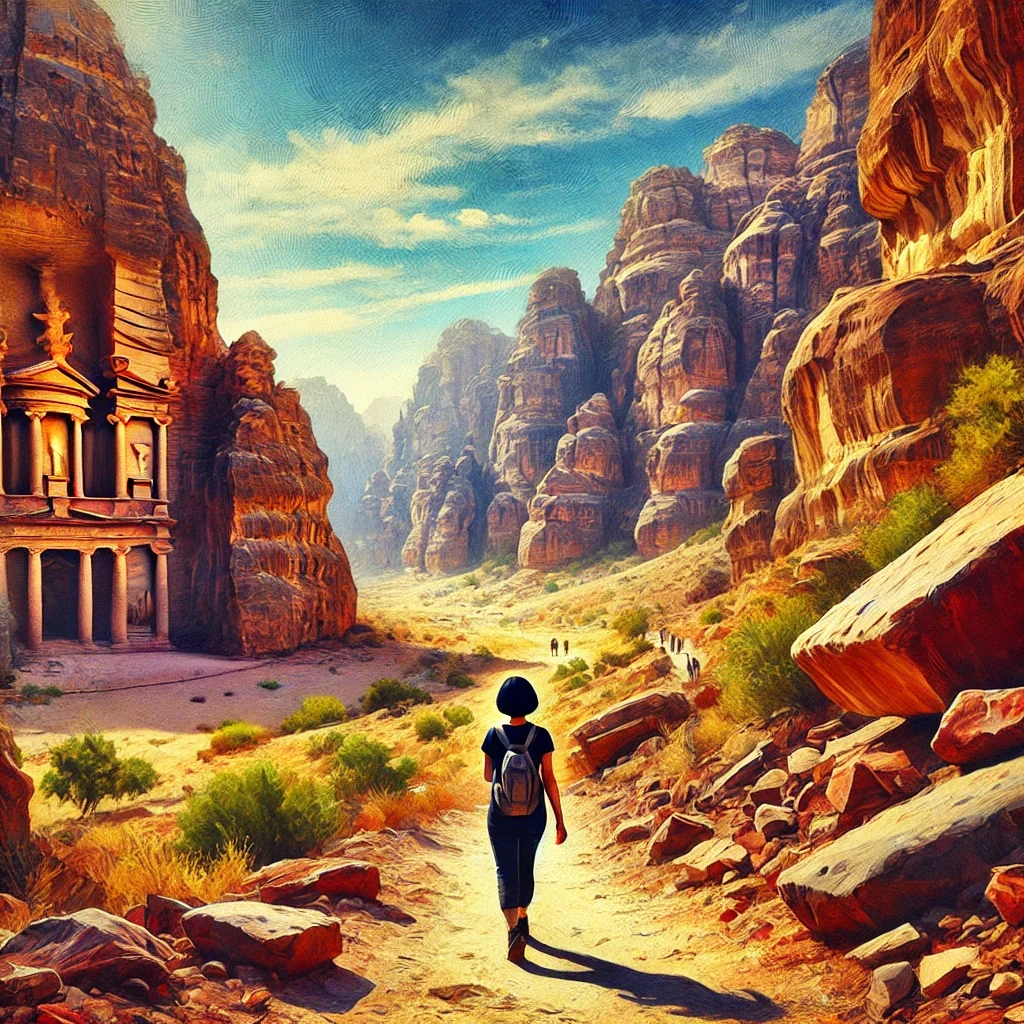ChatGPT:Petra, located in southern Jordan, is an ancient city famous for its rock-cut architecture and water conduit system. It was established as early as 312 BC as the capital city of the Nabataean Kingdom. Petra is often referred to as the “Rose City” due to the color of the stone from which it is carved.
The city is most renowned for its Al-Khazneh (the Treasury), a grandiose tomb carved into the sandstone cliff, and the Siq, a narrow, winding gorge that leads to the city. Petra also includes numerous other tombs, temples, and public buildings, showcasing a blend of Hellenistic architectural styles.
Petra’s significance lies in its unique archaeological and historical value, as well as its role as a major trading hub in ancient times. It was designated a UNESCO World Heritage Site in 1985 and is considered one of the New Seven Wonders of the World. The site is accessible through a two-kilometer-long gorge and continues to be a major tourist attraction, attracting visitors with its stunning rock formations and rich history.
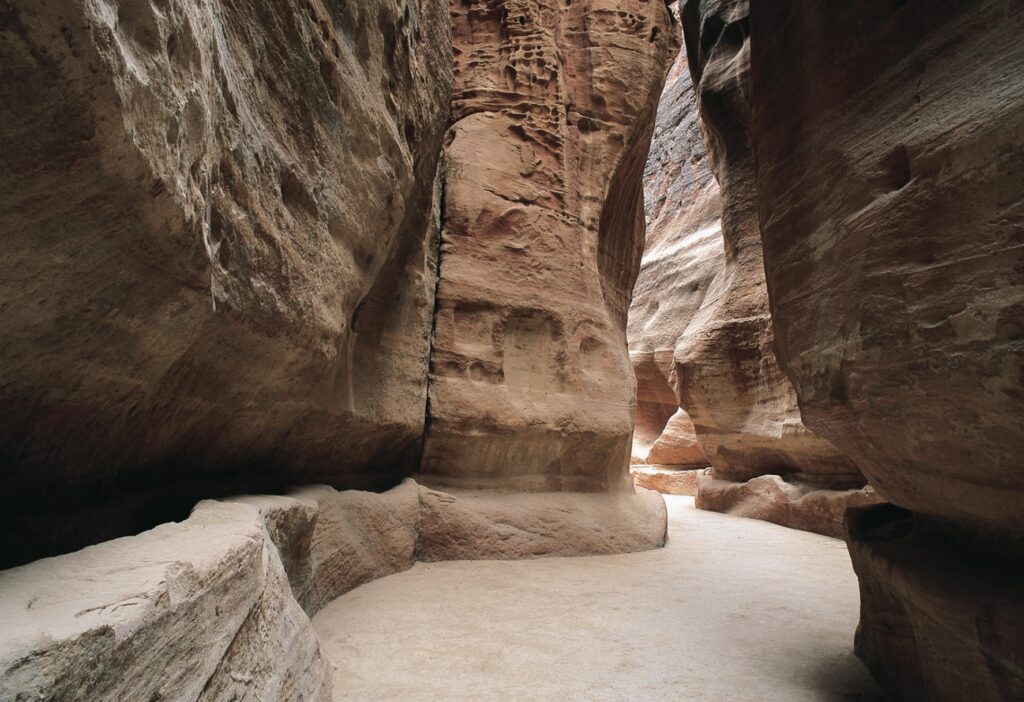
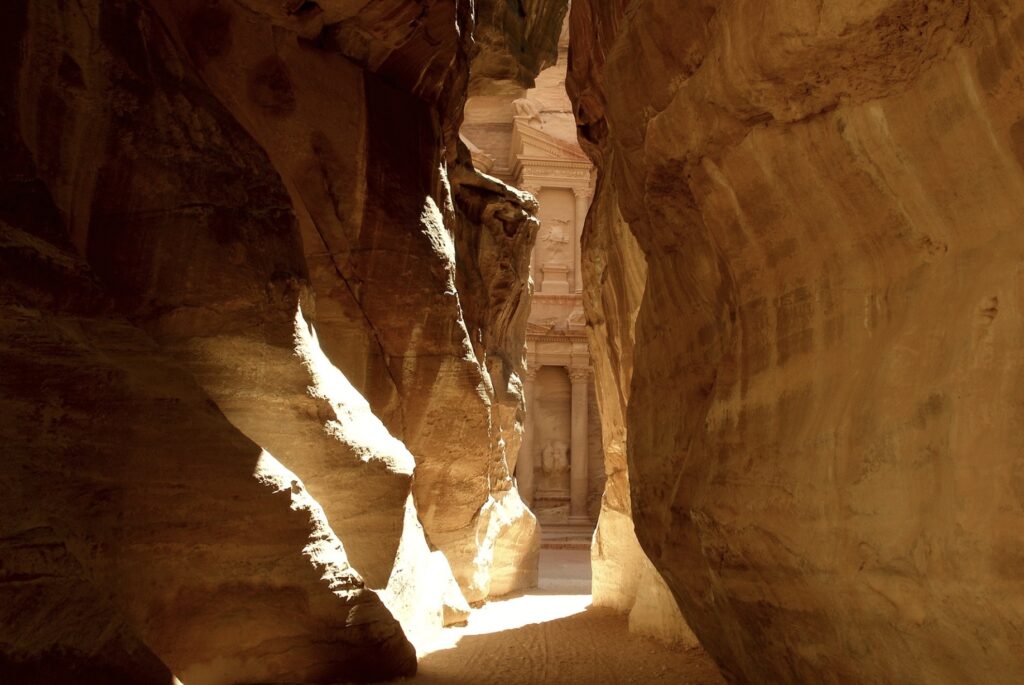
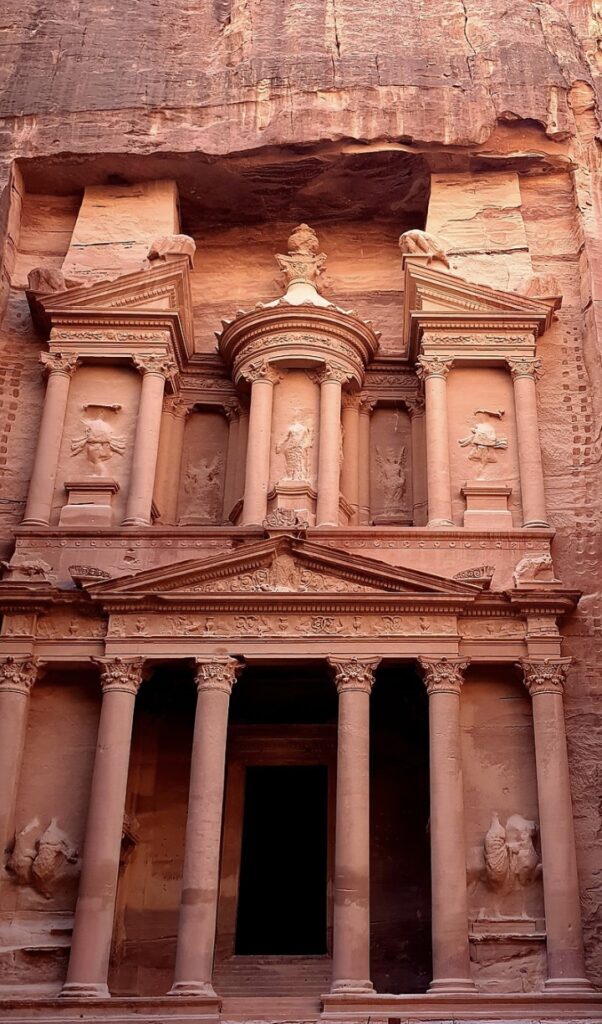
Origin and Early History:
Petra’s origins date back to around the 6th century BC, with the Nabataeans, an ancient Arab people, being its primary architects and inhabitants. The Nabataeans were nomadic Bedouins who gradually settled in the area, capitalizing on Petra’s strategic location at the crossroads of major trade routes linking Arabia, Egypt, and the Mediterranean. This location enabled Petra to become a vital center for the trade of incense, spices, and other valuable goods.
Development and Architecture:
Petra flourished under Nabataean rule, particularly between the 3rd century BC and the 1st century AD. The city’s development was characterized by the construction of elaborate tombs and structures carved directly into the rose-red sandstone cliffs. The Nabataeans were skilled in engineering and hydraulics, creating an intricate water management system that included dams, cisterns, and aqueducts, essential for sustaining life in the arid region.
The architecture of Petra reflects a blend of Nabataean ingenuity and Hellenistic influences, with ornate facades and classical motifs. The most iconic structure, Al-Khazneh (the Treasury), exemplifies this fusion of styles, featuring a grand facade with Corinthian columns and intricate carvings.
Roman Annexation and Later History:
In 106 AD, Petra was annexed by the Roman Empire, becoming part of the Roman province of Arabia Petraea. The Romans continued to develop the city, adding Roman-style structures such as a theater, colonnaded streets, and public baths. Petra remained an important city under Roman rule but gradually declined in prominence as trade routes shifted and new commercial centers emerged.
By the Byzantine era, Petra had largely fallen into obscurity, with only a small Christian community remaining. An earthquake in 363 AD further damaged the city, contributing to its decline.
Rediscovery and Modern Era:
Petra was lost to the Western world for centuries until it was rediscovered in 1812 by Swiss explorer Johann Ludwig Burckhardt. Since then, it has attracted significant archaeological and tourist interest. Excavations and studies have revealed much about Nabataean culture, architecture, and the city’s role in ancient trade networks.
Today, Petra is a UNESCO World Heritage Site and one of the New Seven Wonders of the World, drawing hundreds of thousands of visitors annually. It is not only a symbol of Jordan’s rich cultural heritage but also a remarkable example of ancient engineering and architecture.
The origin of water for Petra primarily came from several natural sources, including springs, flash floods, and collected rainwater. The Nabataeans, who built Petra, developed an advanced water management and storage system to harness these sources effectively. Key aspects of their system included:
- Springs: The primary source of water was a series of natural springs, such as the Ain Musa (Spring of Moses) and the Ain Bebdah, located near Petra. These springs provided a reliable year-round water supply.
- Flash Floods: The region experiences occasional but intense rainfall, leading to flash floods. The Nabataeans built dams and channels to capture and redirect these floodwaters into reservoirs and cisterns, ensuring water availability during dry periods.
- Rainwater Harvesting: The Nabataeans constructed an extensive network of cisterns, reservoirs, and aqueducts to collect and store rainwater. This system allowed them to maximize the use of scarce water resources and sustain the city, especially during the dry season.
This ingenious water management system not only supported the population but also allowed Petra to become a thriving center for trade and agriculture in the arid environment.
Petra is renowned for its impressive historical sites, many of which are carved directly into the rock. Here are some of the main sites:
- Al-Khazneh (The Treasury): One of Petra’s most iconic structures, the Treasury is a magnificent rock-cut temple or tomb. Its elaborately carved facade is adorned with Corinthian columns, sculptures, and friezes.
- The Siq: A narrow, winding gorge that serves as the main entrance to Petra. The Siq is about 1.2 kilometers long and flanked by towering cliffs. It leads directly to the Treasury.
- Ad Deir (The Monastery): Another monumental building similar in style to the Treasury but larger. Located high in the hills, it offers spectacular views of the surrounding area.
- The Street of Facades: A row of monumental Nabataean tombs with elaborate facades, carved into the cliffs along the main road through Petra.
- The Royal Tombs: A group of large tombs situated on the eastern cliff, including the Urn Tomb, the Silk Tomb, the Corinthian Tomb, and the Palace Tomb. These are known for their grand facades and intricate carvings.
- The Great Temple: An extensive complex that includes a large open courtyard, colonnades, and a staircase leading to a temple platform. It reflects the Hellenistic influence on Nabataean architecture.
- The Roman Theater: A large theater capable of seating around 4,000 people, carved into the hillside by the Nabataeans and later expanded by the Romans.
- The Colonnaded Street: A main thoroughfare of Petra, lined with columns and remnants of shops, temples, and other public buildings, reflecting the city’s bustling commercial life.
- The Qasr al-Bint: One of the best-preserved free-standing buildings in Petra, believed to have been a major temple dedicated to the Nabataean god Dushara.
- The High Place of Sacrifice: An ancient altar perched on a mountain top, offering panoramic views of the surrounding area. It was used for religious rituals and ceremonies.
- The Byzantine Church: A structure featuring well-preserved mosaics, highlighting the later Christian presence in Petra during the Byzantine period.
These sites collectively showcase Petra’s rich cultural and architectural history, from its Nabataean roots to Roman and Byzantine influences.
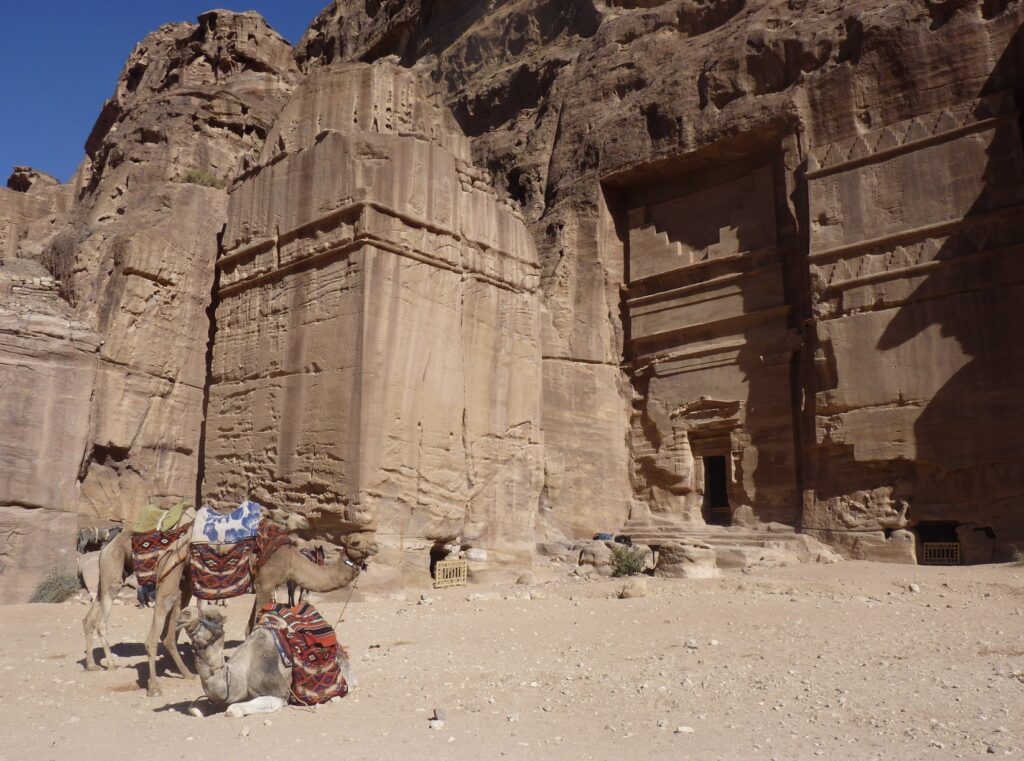
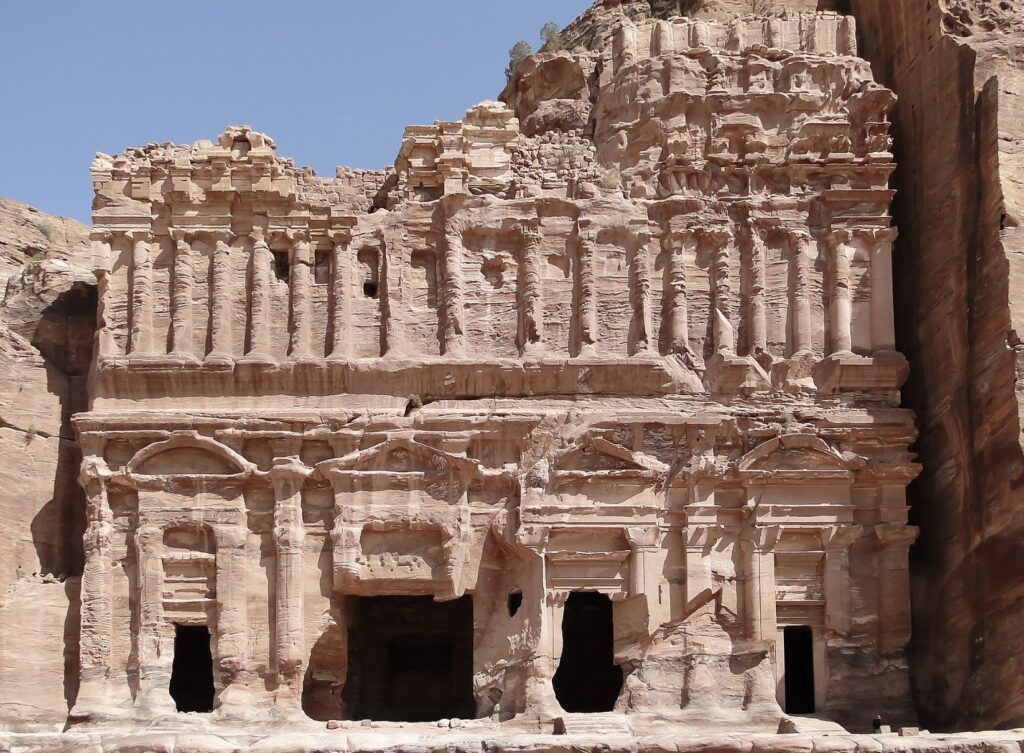
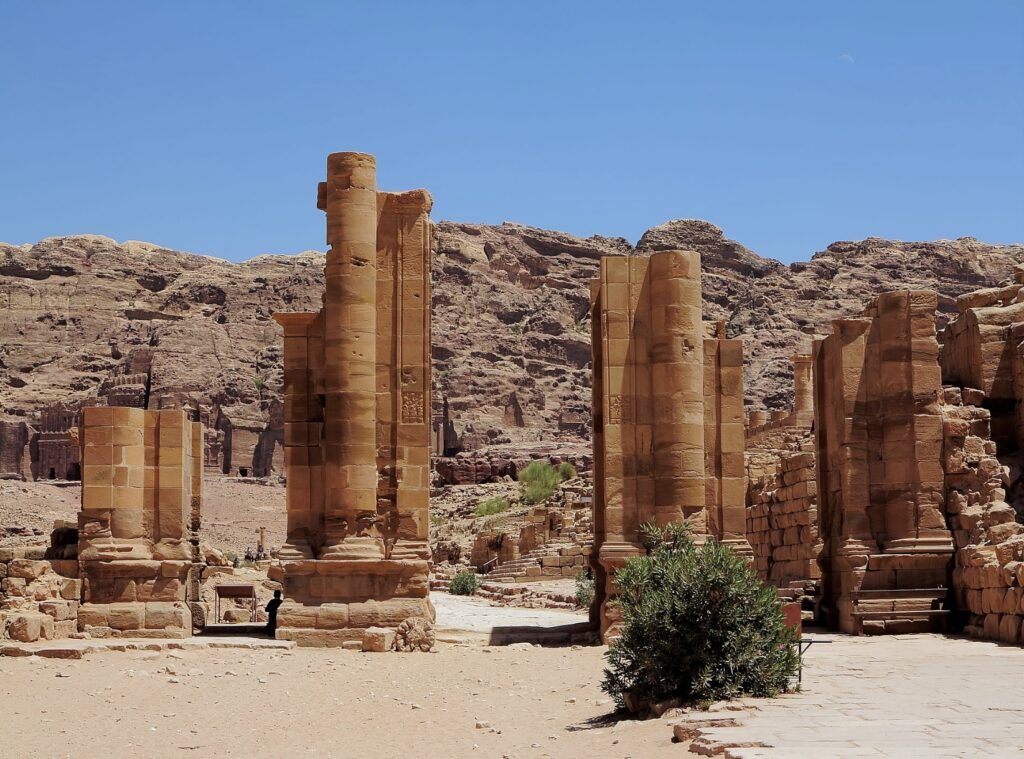
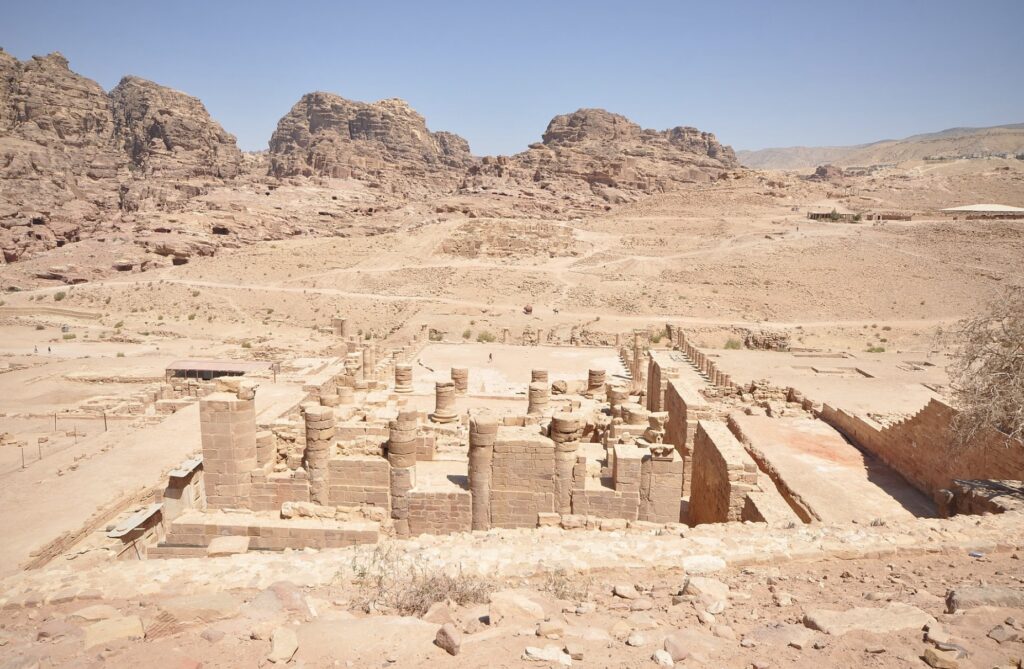
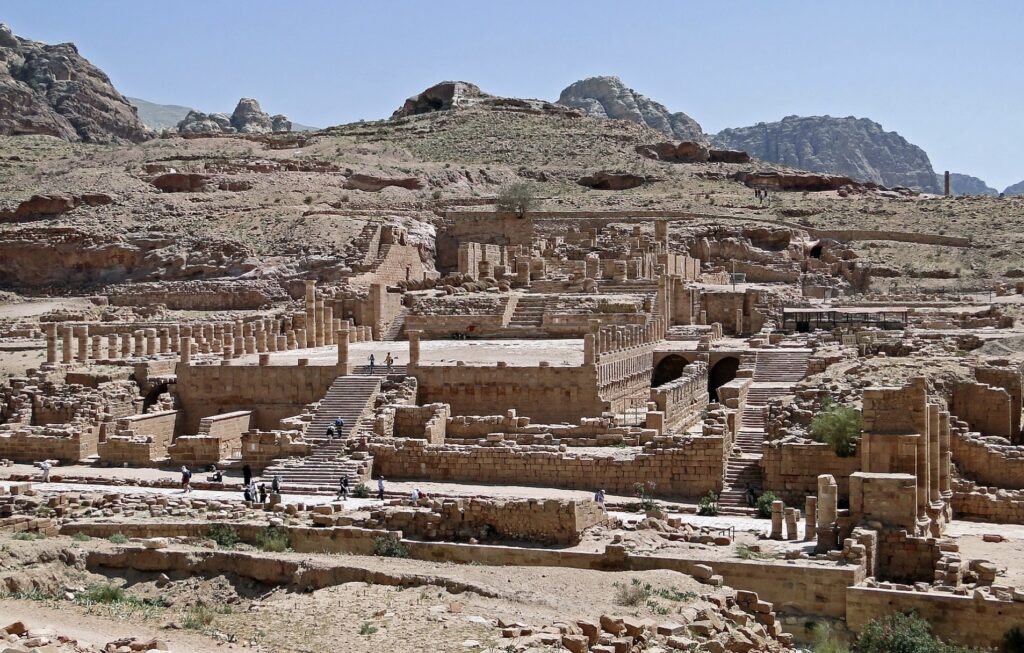
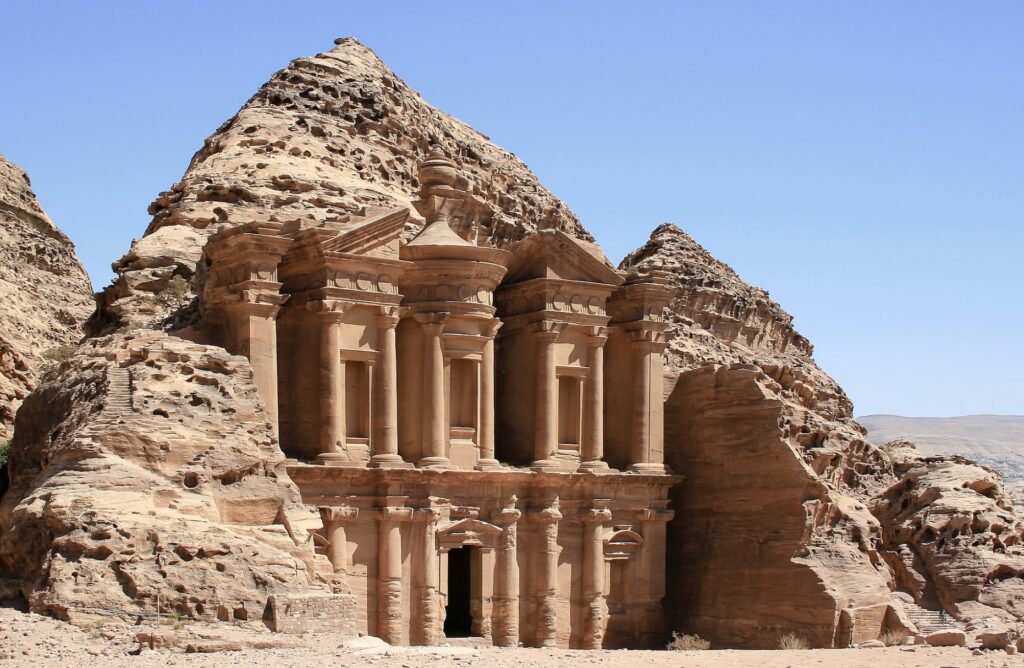
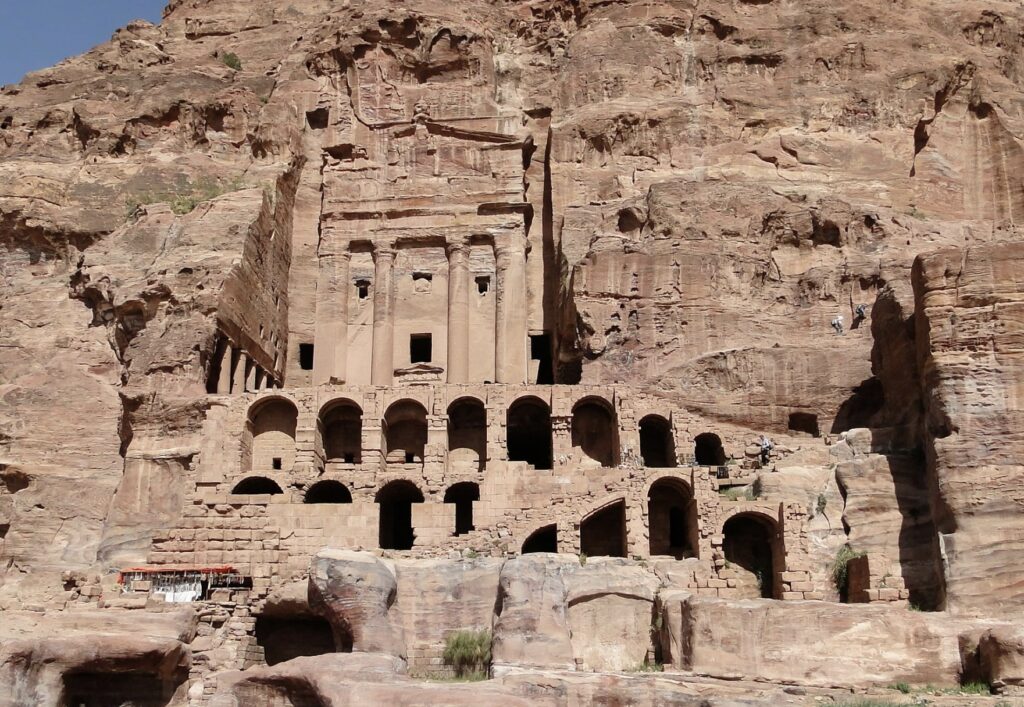
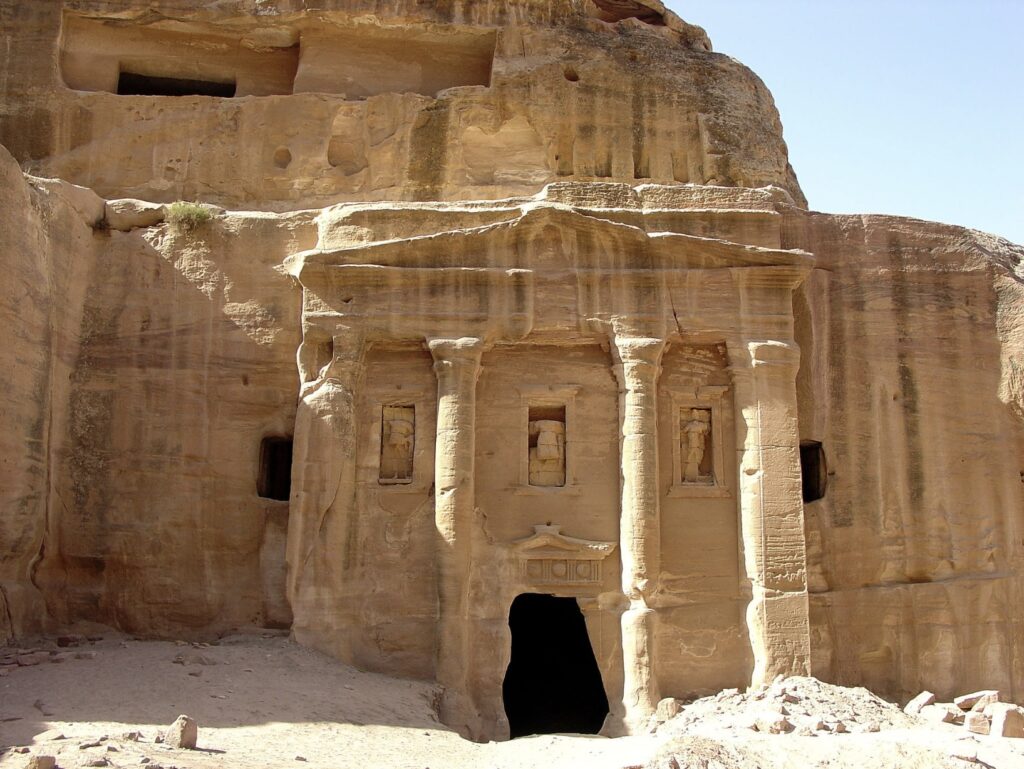
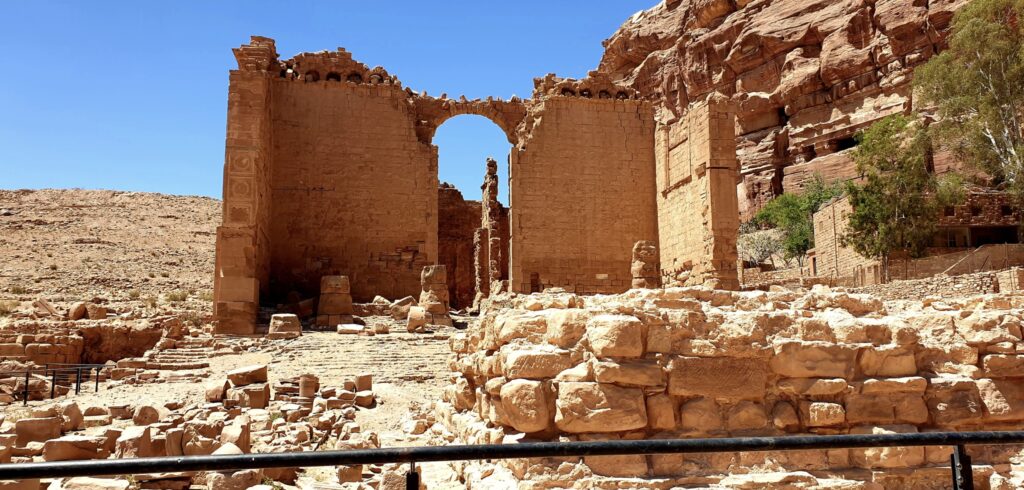
Little Petra, also known as Al-Beidha or Siq al-Barid, is a smaller archaeological site located about 5 kilometers north of the main Petra complex in Jordan. It is considered a satellite site of Petra and shares many similarities in terms of architecture and history. The name “Siq al-Barid” means “Cold Canyon,” likely referring to the narrow gorge that leads into the site, similar to the main Siq of Petra.
Key Features of Little Petra:
- Architecture and Layout:
Little Petra features a series of rock-cut structures, including tombs, temples, houses, and dining halls. These buildings are carved into the sandstone cliffs, similar to the architectural style found in Petra. The structures are smaller and less ornate than those in Petra, but they provide valuable insights into Nabataean life and culture. - Triclinium (Dining Rooms):
One of the notable features of Little Petra is the presence of several triclinia, or dining rooms, which were used for banquets and gatherings. These rooms are carved into the rock and often feature benches along the walls, where guests would recline during meals. - Painted House:
One of the unique finds in Little Petra is a structure known as the “Painted House,” which contains remnants of wall paintings. These frescoes are among the few examples of Nabataean wall art that have survived, depicting vines, birds, and other decorative motifs. - Water Management System:
Like Petra, Little Petra also has an intricate water management system, including channels and cisterns to collect and store water. This was crucial for sustaining the settlement in the arid environment. - Siq al-Barid:
The narrow gorge that leads into Little Petra is called Siq al-Barid. It is shorter and less dramatic than the main Siq at Petra but still provides a picturesque entrance to the site.
Historical Significance:
Little Petra is believed to have served as a suburb or agricultural center for Petra, possibly housing traders and travelers along the trade routes. It may have also functioned as a rest stop for caravans before entering the main city. The presence of dining rooms and the Painted House suggests that it may have hosted social gatherings and feasts.
While not as grand as Petra, Little Petra offers a more intimate and less crowded experience. Its historical and architectural significance makes it an important part of understanding the broader Nabataean civilization and their remarkable achievements in urban planning and engineering.
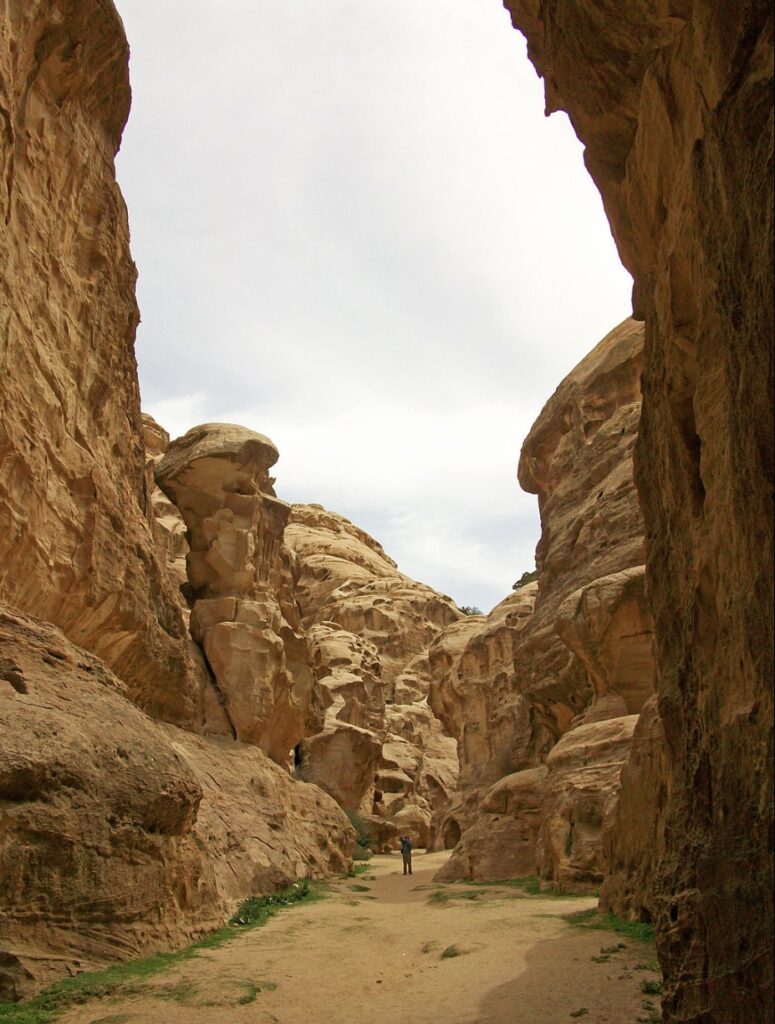
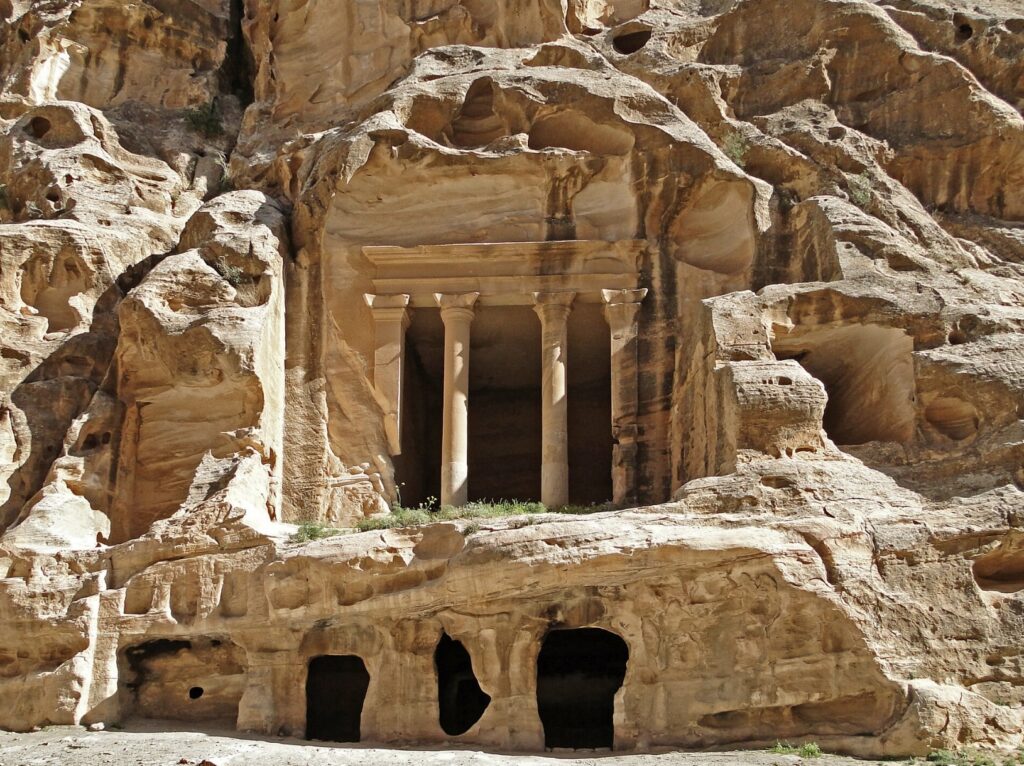
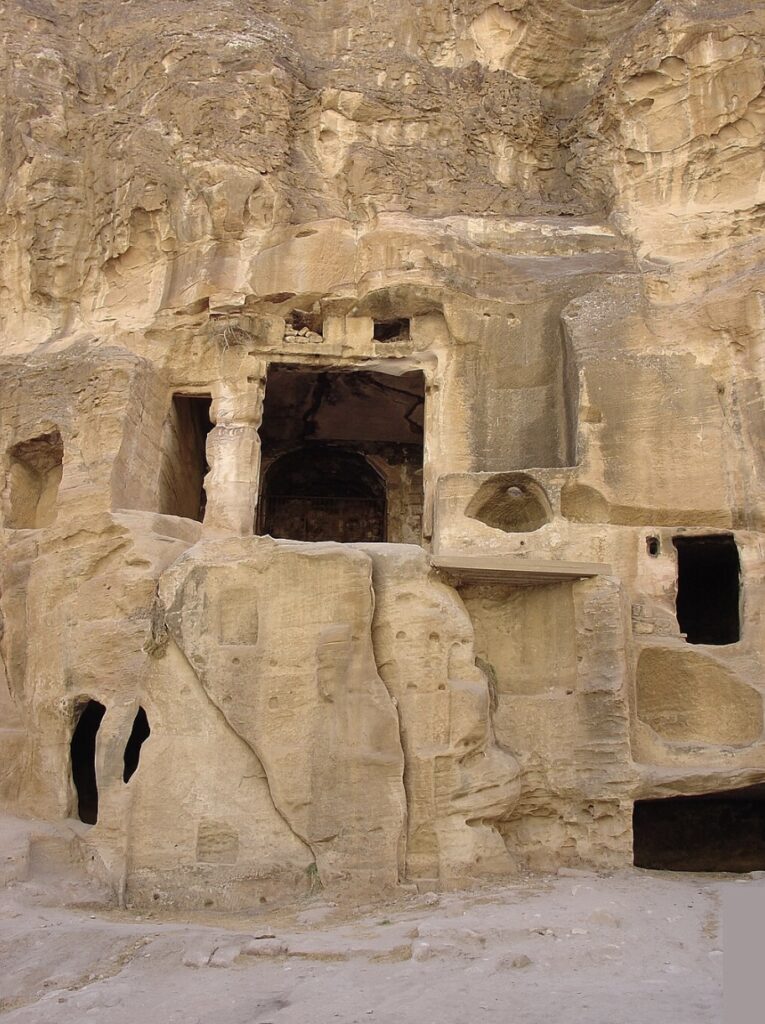
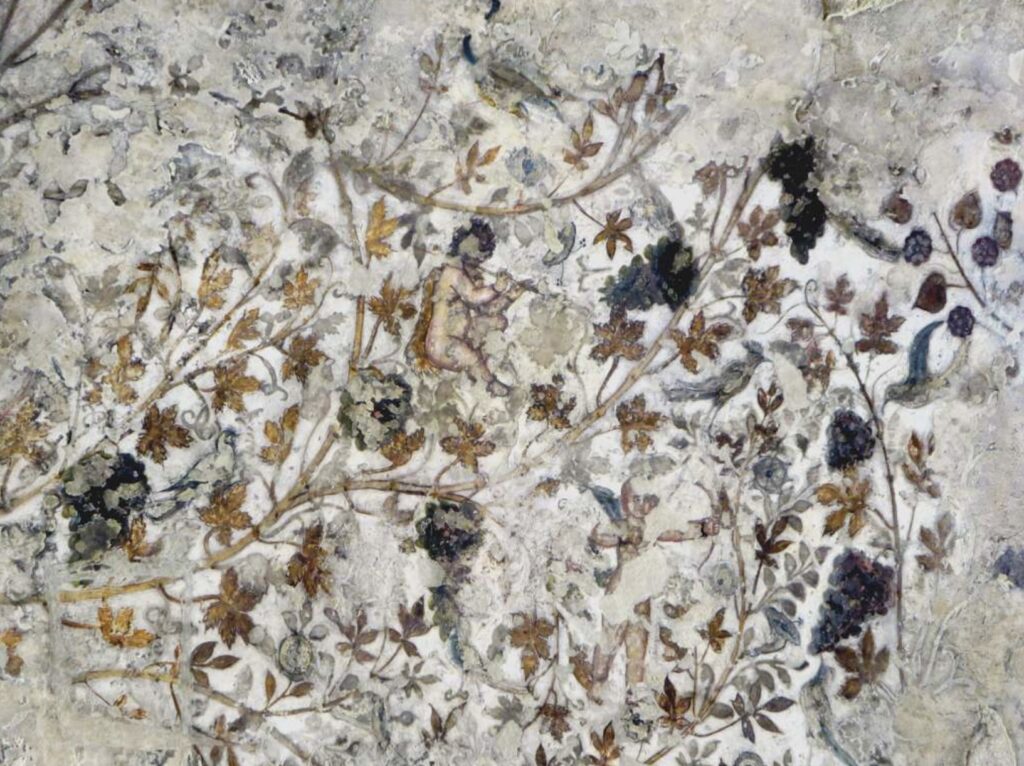
Exploring Petra and its surroundings offers a variety of hiking trails catering to different skill levels. Here are some of the most interesting trails, categorized by difficulty:
Easy Trails:
- The Siq to the Treasury (Al-Khazneh):
- Description: This is the iconic route into Petra, starting from the Visitor Center and passing through the narrow Siq before arriving at the Treasury. It’s a flat and well-paved path, suitable for all visitors.
- Length: Approximately 1.2 kilometers (0.75 miles) one way.
- Highlights: The breathtaking approach to the Treasury, with its stunning facade revealed at the end of the Siq.
- The Colonnaded Street to the Great Temple:
- Description: This trail takes you along Petra’s main thoroughfare, lined with columns and historical buildings. It’s a straightforward, mostly flat walk.
- Length: Around 1 kilometer (0.62 miles) one way.
- Highlights: Roman architecture, the Great Temple, and glimpses of the daily life of ancient Petra.
Moderate Trails:
- The Monastery (Ad Deir) Trail:
- Description: Starting from the Basin Restaurant, this trail involves a steep climb of about 850 steps to reach the Monastery. It offers a rewarding view of one of Petra’s largest and most impressive monuments.
- Length: Approximately 2.5 kilometers (1.55 miles) round trip.
- Highlights: The Monastery’s impressive facade and panoramic views of the surrounding area.
- The High Place of Sacrifice Trail:
- Description: This trail ascends to one of Petra’s highest points, offering excellent views over the city. The route involves climbing steps and navigating rocky terrain.
- Length: Around 3.5 kilometers (2.17 miles) round trip.
- Highlights: The High Place of Sacrifice, offering stunning views and the chance to see ancient sacrificial altars.
Challenging Trails:
- The Al-Khubtha Trail:
- Description: A challenging trail that starts near the Royal Tombs and climbs to a viewpoint above the Treasury. The trail includes steep ascents and uneven terrain.
- Length: Approximately 5 kilometers (3.1 miles) round trip.
- Highlights: A breathtaking panoramic view of the Treasury from above, as well as other impressive vistas of Petra.
- The Jebel Haroun Trail:
- Description: This is one of the longest and most challenging hikes in Petra, leading to the top of Jebel Haroun (Mount Aaron), the highest peak in the area. The trail is rugged and requires good physical fitness.
- Length: About 15 kilometers (9.3 miles) round trip.
- Highlights: The summit offers panoramic views and the shrine of Aaron, believed to be the burial place of the biblical Aaron.
- The Back Route to the Monastery:
- Description: An alternative and less crowded route to the Monastery, starting from Little Petra. It involves hiking through rugged terrain and some steep sections.
- Length: Approximately 8 kilometers (5 miles) one way.
- Highlights: Views of Little Petra, the Monastery from a different perspective, and scenic landscapes.
Each trail offers unique views and experiences, ranging from iconic monuments to lesser-known but equally stunning sites.
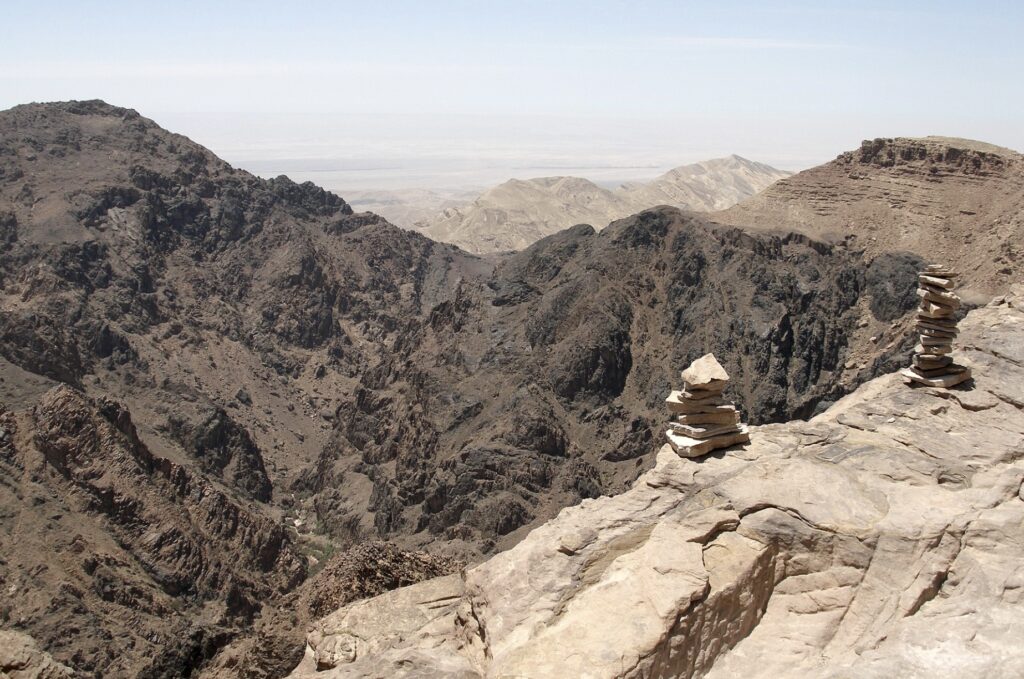
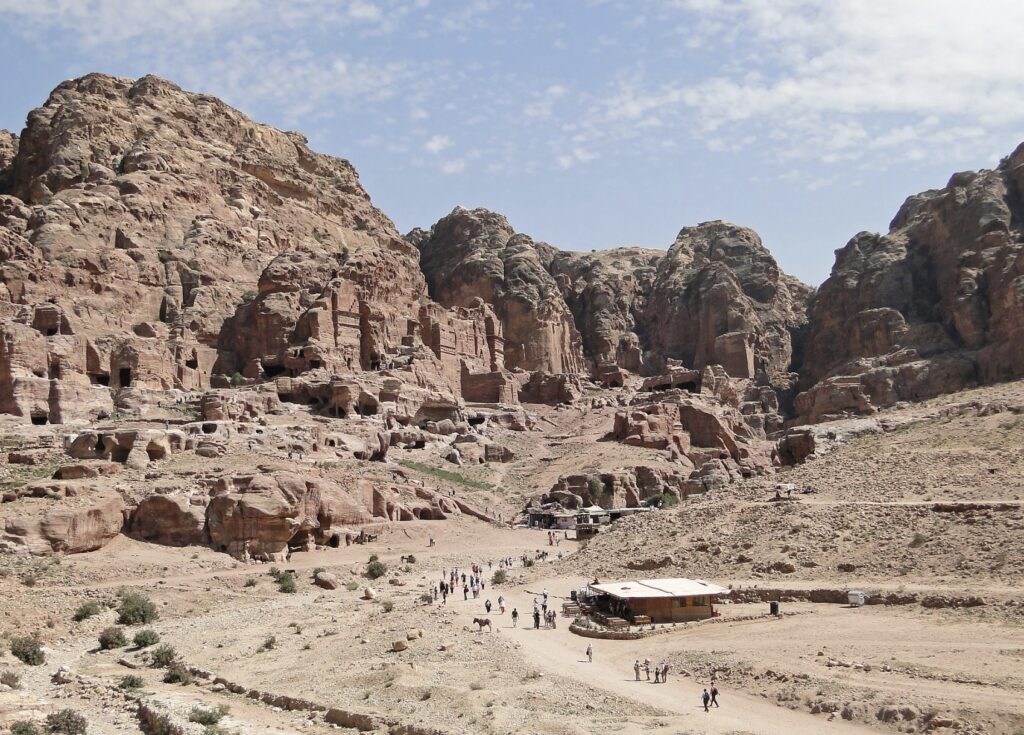
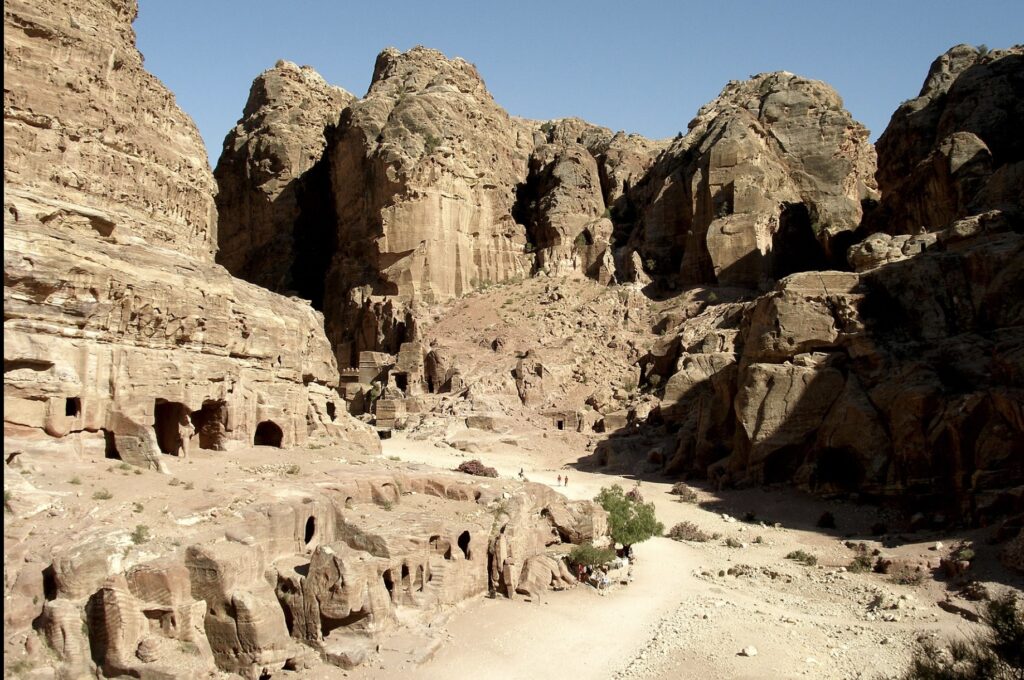
Here’s a suggested two-day itinerary for visiting Petra and Little Petra, with an emphasis on exploring the key sites and enjoying local Jordanian cuisine.
Day 1: Exploring Petra
Morning:
- Start Early at Petra Visitor Center: Arrive early to maximize your time. Begin your journey through the Siq, the narrow, winding gorge that leads to Petra’s most famous site, Al-Khazneh (The Treasury).
- Al-Khazneh (The Treasury): Spend time admiring and photographing the stunning facade.
Mid-Morning:
- The Street of Facades: Walk along this street lined with impressive rock-cut tombs.
- The Royal Tombs: Explore the intricate tombs, including the Urn Tomb and the Silk Tomb.
Lunch:
- Local Lunch at Basin Restaurant: Enjoy traditional Jordanian dishes such as mansaf (lamb cooked in a yogurt sauce), mezze (assortment of small dishes), and freshly baked flatbread.
Afternoon:
- The Colonnaded Street and The Great Temple: Stroll through the main thoroughfare and explore the ruins of the Great Temple.
- The Monastery (Ad Deir): Climb the 850 steps to this magnificent site, one of Petra’s largest monuments. The climb takes about an hour but is well worth it for the views and the grandeur of the Monastery.
Evening:
- Petra by Night: If available, consider experiencing “Petra by Night,” a candlelit visit to the Treasury with traditional music and storytelling. This provides a magical and different perspective on Petra.
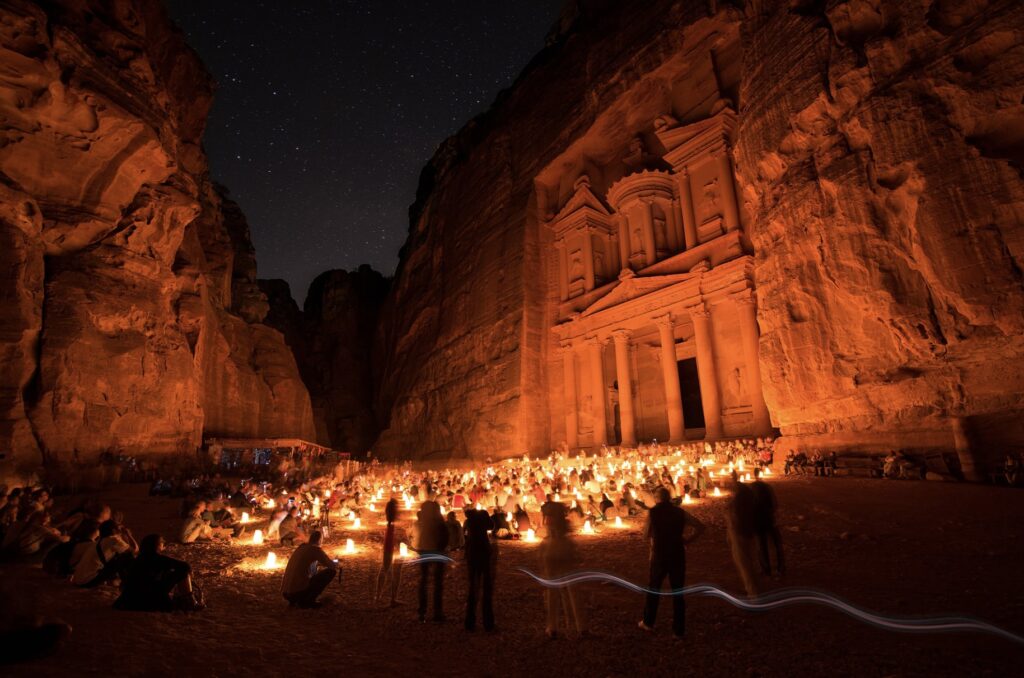
Dinner:
- Dinner at a Local Restaurant in Wadi Musa: After a long day, enjoy a hearty dinner at a local restaurant. Try dishes like maqluba (a layered dish with rice, meat, and vegetables) and kanafeh (a sweet dessert made with cheese and pastry).
Day 2: Little Petra and Surroundings
Morning:
- Visit Little Petra (Al-Beidha): Start your day with a visit to Little Petra. Explore the Siq al-Barid, the rock-cut buildings, and the Painted House with its unique frescoes.
- The Back Route to the Monastery: If you’re up for a hike, take the back route to the Monastery from Little Petra. This trail offers stunning views and a quieter approach to the site.
Lunch:
- Picnic or Lunch at a Local Bedouin Camp: Enjoy a picnic or visit a local Bedouin camp for a traditional meal. Experience Bedouin hospitality with dishes like zarb (a traditional Bedouin barbecue cooked underground) and enjoy tea with herbs.
Afternoon:
- Explore More of Petra: Return to Petra to visit other sites you may have missed or revisit favorites like the High Place of Sacrifice or the Roman Theater.
- Shopping in Wadi Musa: Explore local markets and shops in Wadi Musa for souvenirs, including handmade crafts, jewelry, and spices.
Evening:
- Relaxation and Dinner: After two days of exploring, relax at your hotel or a local café. Enjoy a final meal of Jordanian cuisine, perhaps sampling more mezze, grilled meats, or a dish like shawarma.
Optional Evening Activity:
- Stargazing: If you have time and energy, consider stargazing. The clear skies around Petra offer excellent views of the night sky, especially away from city lights.
This itinerary allows you to fully explore the wonders of Petra and Little Petra while enjoying the rich flavors of Jordanian cuisine. Remember to wear comfortable clothing and sturdy footwear, as there’s a lot of walking and climbing involved. Additionally, staying hydrated and protecting yourself from the sun are important, especially during warmer months.

